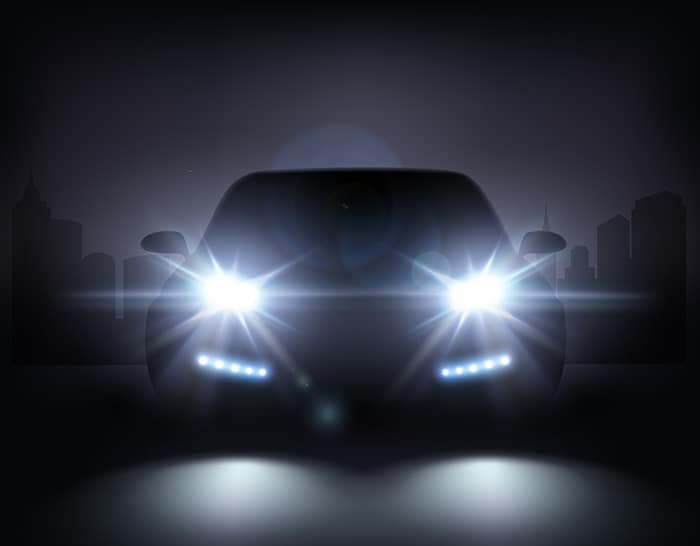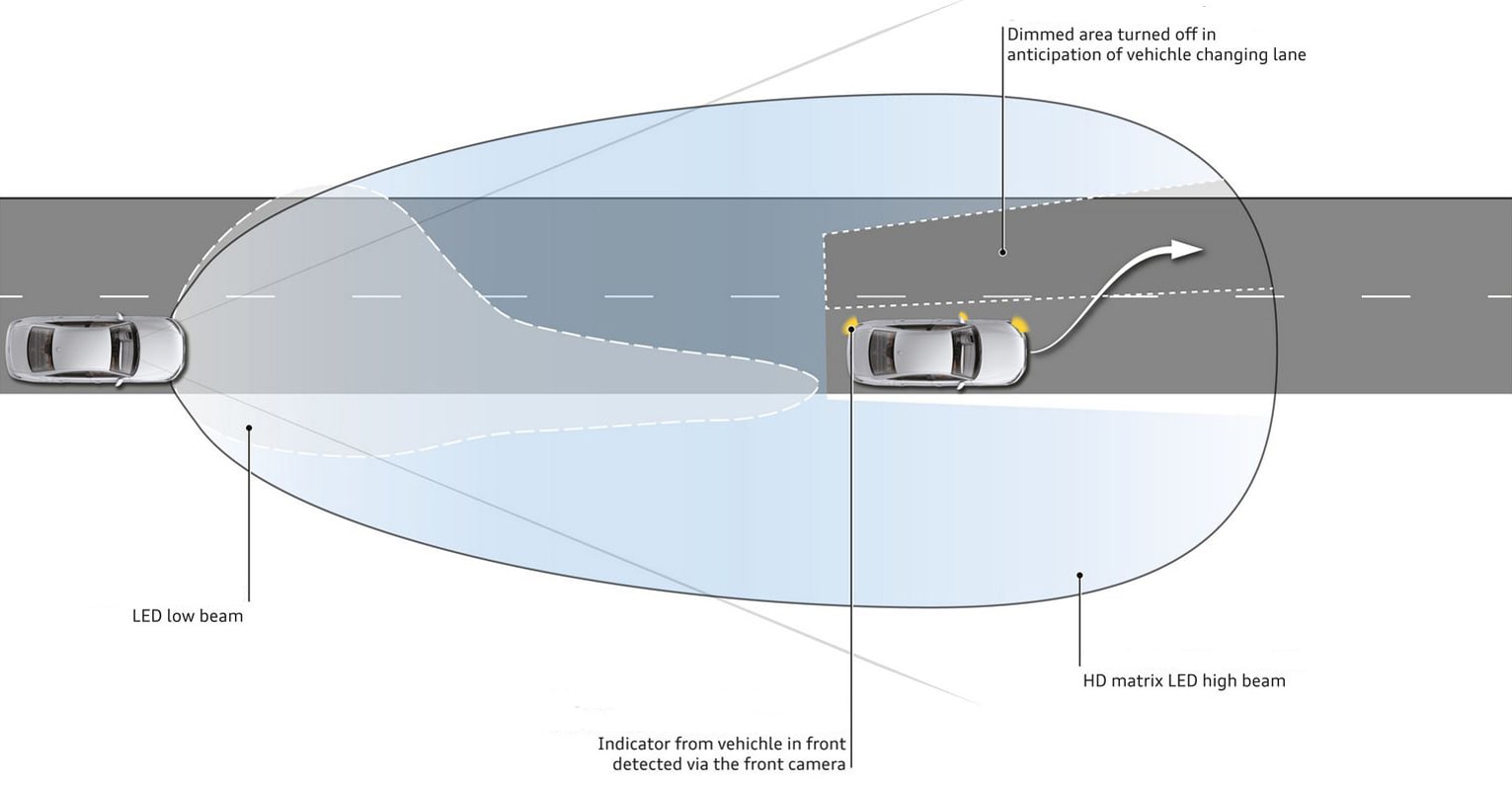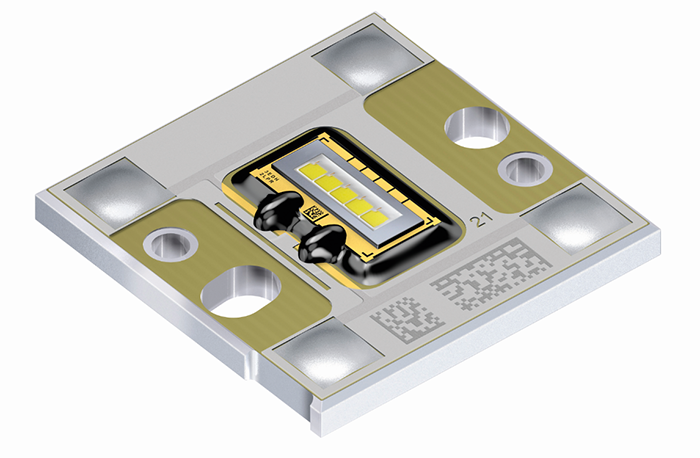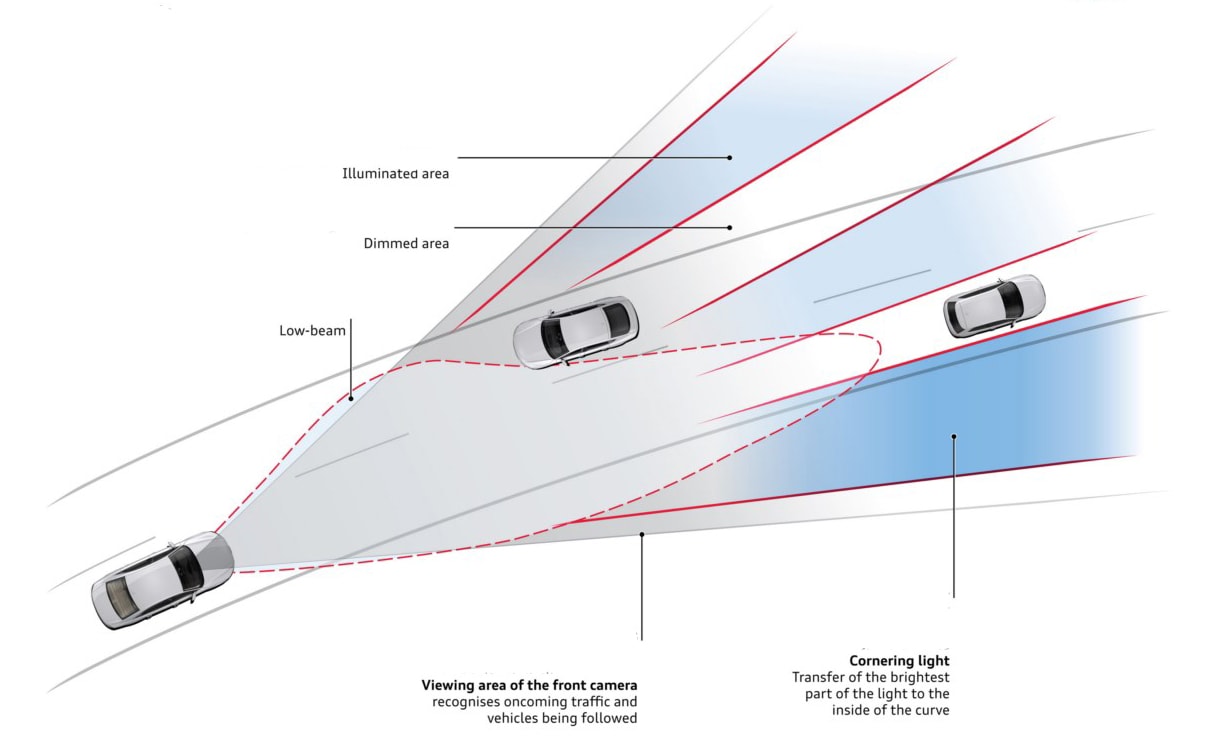The New Ways of Light

Image Source: Macrovector/Shutterstock.com
By Marcel Consée for Mouser Electronics
Published December 7, 2021
Over the last couple of years, car manufacturers have converted the apparent downside of LED lighting—one LED is much weaker than one gas discharge lamp—into a benefit. Today, the arrangement of many LEDs into a matrix array is state of the art. Switching between dipped beam and full beam headlights has become a purely electronic process with the added benefit of glare-free lighting.
Those systems are based on an arrangement of multi-chip-LEDs (their number varying with the price of the car) with individually addressable chips. Using five reflectors with one 5-chip LED each means 25 individual light sources per headlight can be dimmed according to the circumstances. This allows for a variety of light distribution patterns (Figure 1).

Figure 1: Predictive dimming with the HD matrix LED headlight in the Audi A8 (Source: Audi)
A typical LED fixture for applications like these is the Ostar Headlamp Pro by ams OSRAM (Figure 2). A maximum of five ThinGaN/UX chips are mounted on ceramic, connected with contact leads and covered in a special embedding material. For optimal heat dissipation, the ceramic itself is directly mounted to the aluminium of the IMS-PCB. The bond wires are protected against environmental influences utilizing an elastic Globe-Top encapsulant. The metal core substrate provides a sufficiently large surface for a simple thermal connection to the system heat sink.

Figure 2: The Ostar Headlamp is designed for a seamless white colour impression at a maximum brightness level (Source: ams OSRAM)
In automatic mode, the Audi Matrix lighting system activates when the speed exceeds 30 km/h outside city limits or 60 km/h outside. A camera recognizes traffic ahead or oncoming, changing the light distribution by de-activating or dimming individual LEDs (Figure 3).

Figure 3: Beamforming with Audi matrix lighting (Source: Audi)
Oncoming cars are masked, while all areas between the vehicles and on the sides receive full illumination.
Blinkers in the night
Even the direction indicators have evolved into dynamical systems. Multiple segments light up in intervals, and those are part of a combined lighting system that also encompasses position and day-time-running light (DRL) functions.
A so-called marking light works best together with a night vision assistant. When a pedestrian enters a critical area in front of the vehicle, LEDs blink at him.
All of this works together in the headlight modules; they can also offer (predictive) cornering light. Here, the light focus changes with the movement of the steering wheel. Using navigation data, the light beams will even move before the driver turns the wheel (Figure 4).

Figure 4: Predictive cornering light (Source: Audi)
Especially for ultra-slim automotive headlamp designs, ams OSRAM has developed the OSLON Boost HM High Luminance LED. The LED features a high luminance of up to 255cd/m2, and 355lm to 485lm at 1500mA.
Those functions rely on the computing power and speed of the ECUs, and there already are new challenges. A technology that now enters upper-class vehicles combines Matrix LED with laser beams. Full beam or long-distance lights use tiny laser diodes, extending the illuminated distance up to 500m. The laser headlamps are currently being implemented in select vehicle designs from various manufacturers.
Driving LEDs
Many of the LED solutions mentioned above use discrete LEDs with string voltages of up to 60V, or fewer LEDs with a high forward current of 3A or more. Both implementations require DC/DC solutions as boost, buck, or buck-boost architectures. Infineon’s LITIX Power family is an interesting product group where a basic feature set is sufficient, or a Microcontroller is not used.
The TLD5099EP Controller IC includes a pulse width modulator to quickly implement a dimming function with reduced color shifting and a spread spectrum modulator to improve the EMI performance. It is designed to support fixed-current and fixed-voltage configurations in topologies like boost, buck, buck-boost, SEPIC, and flyback, by simply adjusting the external components. The device offers flexible dimming via analog or PWM outputs. The shut-down current is reduced to QOFF <15µA at 105°C. The current mode control scheme provides a stable regulation loop maintained by small external compensation components. Additionally, an integrated soft-start feature limits the current peak as well as voltage overshoot at start-up.
Conclusion
With the advancements in LED manufacturing technology, new approaches to driver topologies, and the combination of different techniques, automotive lighting becomes a fully integrated solution. Relinquishing mechanical beam switching removes a well-known source of errors from the game, and the new lighting modules can be seamlessly integrated into automotive control networks. Increased driver and traffic safety, as well as reduced power consumption, make these solutions ideal for electromobility and autonomous functionality.